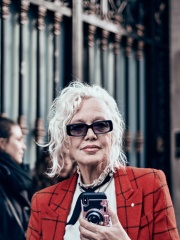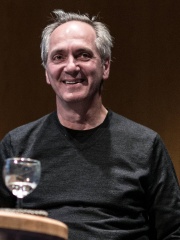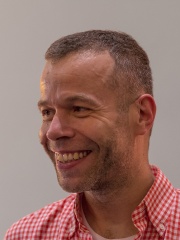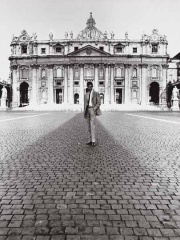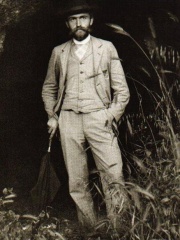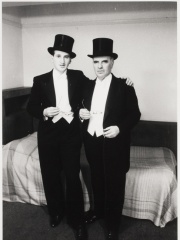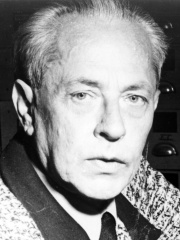
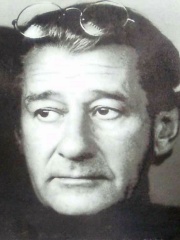
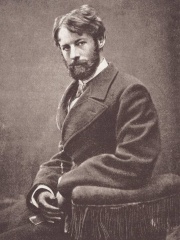
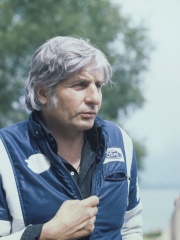
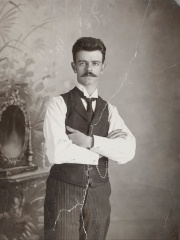
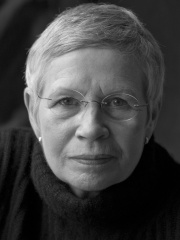
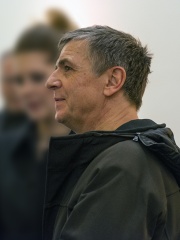
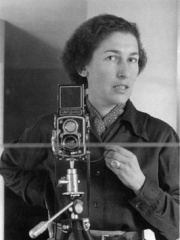
The Most Famous
PHOTOGRAPHERS from Germany
This page contains a list of the greatest German Photographers. The pantheon dataset contains 148 Photographers, 20 of which were born in Germany. This makes Germany the birth place of the 3rd most number of Photographers behind United States, and France.
Top 10
The following people are considered by Pantheon to be the top 10 most legendary German Photographers of all time. This list of famous German Photographers is sorted by HPI (Historical Popularity Index), a metric that aggregates information on a biography's online popularity. Visit the rankings page to view the entire list of German Photographers.

1. Heinrich Hoffmann (1885 - 1957)
With an HPI of 72.48, Heinrich Hoffmann is the most famous German Photographer. His biography has been translated into 31 different languages on wikipedia.
Heinrich Hoffmann (12 September 1885 – 16 December 1957) was a Nazi politician and publisher who was Adolf Hitler's official photographer and a member of his inner circle. Hoffmann's photographs were a significant part of Hitler's propaganda campaign to present himself and the Nazi Party as a significant mass phenomenon. He received royalties from all uses of Hitler's image, which made him a millionaire over the course of Hitler's rule. After the Second World War he was tried and sentenced to 10 years in prison for war profiteering. He was classified by the Allies' Art Looting Investigators to be a "major offender" in Nazi art plundering of Jews, as both art dealer and collector. His art collection, which contained many artworks looted from Jews, was subsequently confiscated by the Allies. Hoffmann's sentence was reduced to four years on appeal, and he was released from prison in 1950. In 1956, the Bavarian State ordered all art under its control and formerly possessed by Hoffmann to be returned to him.

2. Helmut Newton (1920 - 2004)
With an HPI of 71.10, Helmut Newton is the 2nd most famous German Photographer. His biography has been translated into 39 different languages.
Helmut Newton (né Neustädter; 31 October 1920 – 23 January 2004) was a German-Australian photographer. The New York Times described him as a "prolific, widely imitated fashion photographer whose provocative, erotically charged black-and-white photos were a mainstay of Vogue and other publications."

3. Wilhelm von Gloeden (1856 - 1931)
With an HPI of 66.01, Wilhelm von Gloeden is the 3rd most famous German Photographer. His biography has been translated into 26 different languages.
Wilhelm Iwan Friederich August von Gloeden (September 16, 1856 – February 16, 1931), commonly known as Baron von Gloeden, was a German photographer who worked mainly in Italy. He is mostly known for his pastoral nude studies of Sicilian boys, which usually featured props such as wreaths or amphoras, suggesting a setting in the Greece or Italy of antiquity. His work demonstrates the controlled use of lighting as well utilizing elegant poses of his models. His innovations include the use of photographic filters and special body makeup (a mixture of milk, olive oil, and glycerin) to disguise skin blemishes. His work, both landscapes and nudes, drew wealthy tourists to Sicily, particularly gay men uncomfortable in northern Europe.

4. Gunter Sachs (1932 - 2011)
With an HPI of 65.24, Gunter Sachs is the 4th most famous German Photographer. Her biography has been translated into 20 different languages.
Fritz Gunter Sachs, (14 November 1932 – 7 May 2011) also known as Gunter Sachs von Opel, was a German-born Swiss industrial heir, socialite, art collector, photographer, and author. He was primarily known for his jet set lifestyle in St. Moritz and St. Tropez and then gained international fame as a documentary film-maker, documentary photographer, and as third husband of Brigitte Bardot.
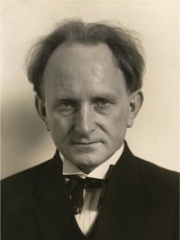
5. August Sander (1876 - 1964)
With an HPI of 64.69, August Sander is the 5th most famous German Photographer. His biography has been translated into 24 different languages.
August Sander (17 November 1876 – 20 April 1964) was a German portrait and documentary photographer. His first book Face of our Time (German: Antlitz der Zeit) was published in 1929. Sander has been described as "the most important German portrait photographer of the early twentieth century". Sander's work includes landscape, nature, architecture, and street photography, but he is best known for his portraits, as exemplified by his series People of the 20th Century. In this series, he aims to show a cross-section of society during the Weimar Republic.

6. Guillermo Kahlo (1871 - 1941)
With an HPI of 63.62, Guillermo Kahlo is the 6th most famous German Photographer. Her biography has been translated into 17 different languages.
Guillermo Kahlo (born Carl Wilhelm Kahlo; 26 October 1871 – 14 April 1941) was a German-born Mexican-naturalized photographer. He photographically documented important architectural works, churches, streets, landmarks, as well as industries and companies in Mexico at the beginning of the 20th century; because of this, his work has not only artistic value but also historical and documental importance. He was the father of painter Frida Kahlo.

7. Astrid Kirchherr (1938 - 2020)
With an HPI of 62.62, Astrid Kirchherr is the 7th most famous German Photographer. Her biography has been translated into 28 different languages.
Astrid Kirchherr ([ˈastʁɪt ˈkɪʁçhɛʁ]; 20 May 1938 – 12 May 2020) was a German photographer and artist known for her association with the Beatles (along with her friends Klaus Voormann and Jürgen Vollmer) and her photographs of the band's original members — John Lennon, Paul McCartney, George Harrison, Stuart Sutcliffe and Pete Best — during their early days in Hamburg. Kirchherr met artist Stuart Sutcliffe in the Kaiserkeller bar in Hamburg in 1960, where Sutcliffe was playing bass with the Beatles, and was later engaged to him, before his death in 1962. Although Kirchherr shot very few photographs after 1967, her early work has been exhibited in Hamburg, Bremen, London, Liverpool, New York City, Washington, D.C., Tokyo, Vienna, and at the Rock 'n' Roll Hall of Fame. She published three limited-edition books of photographs.

8. Andreas Gursky (b. 1955)
With an HPI of 62.41, Andreas Gursky is the 8th most famous German Photographer. His biography has been translated into 34 different languages.
Andreas Gursky (born 15 January 1955) is a German artist and a former professor at the Kunstakademie Düsseldorf, Germany. He is known for his large-scale colour photographs of architecture, landscapes and contemporary life—crowds, consumer goods and the infrastructures of global capitalism—combining methodical observation with digital construction to achieve an all-over, hyper-detailed image field. His works reach some of the highest prices in the art market. His photograph Rhein II was sold at Christie's for $4,338,500 on 8 November 2011. At the time it was the most expensive photograph ever sold at auction, and it remains the most expensive photograph by a living photographer. He was also involved in the establishment of the Deutsches Fotoinstitut (German Institute for Photography) in Düsseldorf, the first national institution for photography in Germany.

9. Gisèle Freund (1908 - 2000)
With an HPI of 61.86, Gisèle Freund is the 9th most famous German Photographer. Her biography has been translated into 22 different languages.
Gisèle Freund (born Gisela Freund; 19 December 1908 – 31 March 2000) was a German-born French photographer and photojournalist, famous for her documentary photography and portraits of writers and artists. Her best-known book, Photographie et société (1974), is a expanded edition of her seminal 1936 dissertation. It was the first sociohistorical study on photography as a democratic medium of self-representation in the age of technological reproduction. With this first doctoral thesis on photography at the Sorbonne, she was one of the first women habilitated there. Freund's major contributions to photography include using the Leica Camera (with its ability to house 35 mm film rolls with 36 frames) for documentary reportage and pioneering Kodachrome and Agfacolor positive film for colour portraits of writers and artists, which allowed her to develop a "uniquely candid portraiture style" that distinguishes her in 20th-century photography. Politically left-leaning all her life, she became president of the French Union of Photographers in 1977. In 1981, she took the official portrait of French President François Mitterrand, and was made Officier des Arts et Lettres in 1982 and Chevalier de la Légion d'honneur, the highest decoration in France, in 1983. In 1985, she became the first photographer to be honored with a retrospective at the Musée national d'art moderne in Paris.
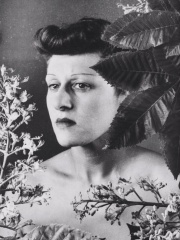
10. Grete Stern (1904 - 1999)
With an HPI of 60.22, Grete Stern is the 10th most famous German Photographer. Her biography has been translated into 17 different languages.
Grete Stern (9 May 1904 – 24 December 1999) was a German-Argentine photographer. Between April 1930 and March 1933, she studied at the Bauhaus. With her husband Horacio Coppola, she helped modernize the visual arts in Argentina, and presented the first exhibition of modern photographic art in Buenos Aires, in 1935.
People
Pantheon has 20 people classified as German photographers born between 1856 and 1968. Of these 20, 4 (20.00%) of them are still alive today. The most famous living German photographers include Andreas Gursky, Ellen von Unwerth, and Thomas Struth. The most famous deceased German photographers include Heinrich Hoffmann, Helmut Newton, and Wilhelm von Gloeden.
Living German Photographers
Go to all RankingsAndreas Gursky
1955 - Present
HPI: 62.41
Ellen von Unwerth
1954 - Present
HPI: 56.10
Thomas Struth
1954 - Present
HPI: 54.96
Wolfgang Tillmans
1968 - Present
HPI: 52.45
Deceased German Photographers
Go to all RankingsHeinrich Hoffmann
1885 - 1957
HPI: 72.48
Helmut Newton
1920 - 2004
HPI: 71.10
Wilhelm von Gloeden
1856 - 1931
HPI: 66.01
Gunter Sachs
1932 - 2011
HPI: 65.24
August Sander
1876 - 1964
HPI: 64.69
Guillermo Kahlo
1871 - 1941
HPI: 63.62
Astrid Kirchherr
1938 - 2020
HPI: 62.62
Gisèle Freund
1908 - 2000
HPI: 61.86
Grete Stern
1904 - 1999
HPI: 60.22
Lothar Wolleh
1930 - 1979
HPI: 59.89
Karl Blossfeldt
1865 - 1932
HPI: 59.23
Erich Salomon
1886 - 1944
HPI: 59.08
Overlapping Lives
Which Photographers were alive at the same time? This visualization shows the lifespans of the 15 most globally memorable Photographers since 1700.

